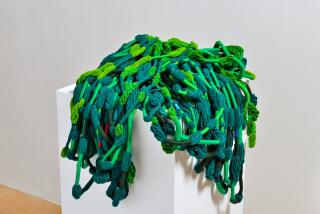* Conrad Marca-Relli; Revolutionized Collage
- Share via
Conrad Marca-Relli, 87, an Italian American collagist who served as a link between the European avant-garde and American abstract Expressionism. His greatest contribution came in the 1950s, when he revolutionized the medium of collage by adding strips of canvas over the canvas and painting them over in a subdued palette--”a painting with oil and canvas,” in one critic’s words. Marca-Relli’s style blended classicism with surrealism and some of the playful improvisations of his abstract Expressionist friends, such as Willem de Kooning and Jackson Pollock. Always open to influences from abroad, Marca-Relli began adding strips of canvas to his paintings after running out of paint during a Mexico trip in 1953. Soon afterward, he created monumental-sized collages, such as the 1956 “Trial,” and by the 1960s he was replacing canvas with scrap materials, such as aluminum and vinyl. “He was the first artist who took collage to monumental proportions,” said Marco Niccoli, owner of an art gallery in Parma, Italy, that has exhibited Marca-Relli’s work for 15 years. “He always considered his work as unfinished, and collage allowed him to intervene again, to rework a piece after decades, to let--theoretically at least--the possibility of change.” The Boston-born Marca-Relli had his first solo exhibit, focused on surrealist works, in New York in 1947. In the 1950s, his recognition increased in the United States as he taught at Yale and UC Berkeley. On Tuesday of a heart attack at his home in Parma.
More to Read
The biggest entertainment stories
Get our big stories about Hollywood, film, television, music, arts, culture and more right in your inbox as soon as they publish.
You may occasionally receive promotional content from the Los Angeles Times.










